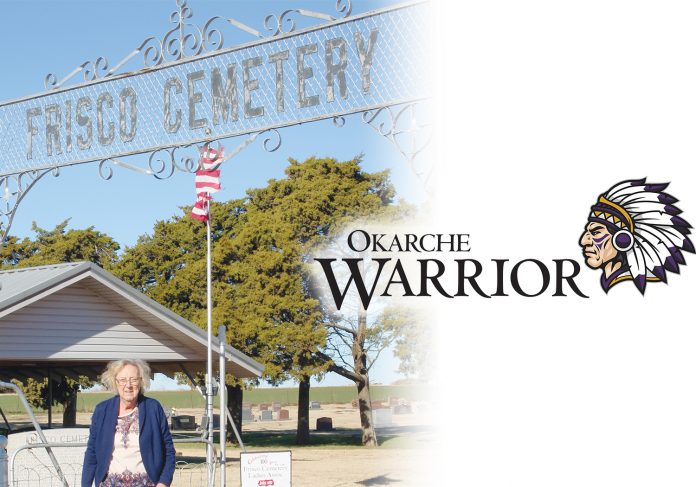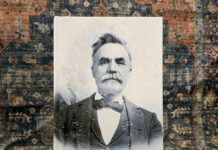
By Carol Mowdy Bond
Contributing Writer
The Frisco Cemetery’s 130th birthday is January 6.
Many Canadian County residents have the town of Frisco, Oklahoma Territory, tucked into their memories. But if you ask them where it was located, they’ll likely point and say it was someplace in that direction.
However, if you ask the cemetery’s secretary, Jean Wiedemann Kyle, where it was, she’ll give you a better answer.
Jean Kyle said, “The east-west road was Foreman Road. And the north-south road was Frisco Road. Frisco was located on the west side of Frisco Road, about a half mile north of Foreman Road. There was a Frisco schoolhouse on the southeast corner of Foreman and Frisco roads. And there used to be a sign nailed to a fence post to show where the town was located. It may still be there.”
Unfortunately, Frisco officially dissolved in 1905, just two years shy of Oklahoma statehood.
So, if not for people like Jean, information about the town might be lost forever.
Jean Kyle and her husband, John, are living on the 160-acre homestead owned by Richard Griffin, Jean’s great-grandfather. And since 1996, Jean Kyle has been the official secretary for the Frisco Cemetery, located at 14200 W. Britton Road, Yukon, just a smidge west of Piedmont Road. The cemetery grew in size from the land Richard deeded from his homestead land, and the cemetery has continued to grow due to the need for more burial plots. In fact, there were two more burials at the cemetery the week prior to Christmas 2020.
Jean Kyle’s mother, Mildred Wiedemann, held the secretary position before Jean. Mildred also relished the title of “unofficial historian for the Frisco area.” Following in her mom’s footsteps, Jean has collected reams of information and created scads of notebooks about Frisco and other history of the area.
Jean Kyle said, “I have a lot of family buried in the Frisco Cemetery on all sides of my family. Wiedemanns. Griffins. Newmans.”
JEAN KYLE’S GREAT-GRANDFATHER
Richard Griffin sold his land when he fell on hard times. But in 1976, Jean and John Kyle saw an opportunity and bought the family farm. “We’ve farmed it,” Jean Kyle said. “But it’s been hard.”
Born in 1860 in Missouri, Richard gravitated to Oklahoma Territory, searching for farmland.
In fall 1896, he purchased land owned by Carrie and Ansel Cooper. Richard then returned to Missouri and collected his family.
Ansel’s name appears in the 1890 First Territorial Census of Oklahoma. A native of Ohio, Ansel served in the 142nd Indiana Infantry during the Civil War. He moved his family from Kansas to settle in the Canadian Valley, filing the deed for his land in the Kingfisher Land Office, December 1889. On January 6, 1890, Ansel deeded one acre of his land to Frisco for a cemetery. This is the land that he would later sell to Richard Griffin, and it was the beginning of today’s Frisco Cemetery.
In August 1897, Richard deeded two acres of his farm to the Frisco Cemetery. In so doing, Richard enlarged what the Coopers had already set aside. The Frisco newspaper tells that the first burial occurred in February 1890. Along with his son Archie, John Turner, founder of Yukon’s first funeral home, handled 80% to 90% of the Frisco Cemetery burials.
The cemetery is home to graves of many of the area’s pioneers and their descendants. And the most famous person buried there is likely U.S. Marshal Christian “Chris” Madsen. He, along with William “Bill” Tilghman, and Henry “Heck” Thomas, were known as the Three Guardsmen of Oklahoma. In the late 1800s, the colorful and fearless trio brought much-needed law and order to the Twin Territories, crossing swords with some of the area’s most notorious criminals.
Of the Frisco Cemetery, Mildred believed some of the graves were moved from a cemetery in the town of Frisco, about a mile away, after the town government was dissolved in 1905.
In 1909, a decision was made to move the church from Frisco to the cemetery. Richard deeded another half acre for a church site. He served on the cemetery’s board of directors, and he was a trustee for the Frisco township, and he served on the Richland School Board.
Unfortunately, the house belonging to Richard and his wife caught fire in February 1918. All the family members survived. But they lost everything, and they lived in a tent until they could rebuild. And the Frisco Cemetery records to date were lost in the fire.

THE BIRTH AND DEATH OF FRISCO
There are several variations about the story of Frisco’s origins. And likely there’s a bit of truth in all. But the short, compressed version is that Civil War veterans received first dibs on land that was opening to white settlement of Native American lands. Dr. J. M. Minnick decided to carve out a veteran’s colony in the soon-to-be-opened Oklahoma Territory lands. He and a large group of vets from Kansas sent a scouting party by wagon down the Chisholm Trail.
And by the time it was all said and done, they decided on land in the Canadian Valley area, with its black loam soil. There was plenty of timber in the area.
As well, there were springs and creeks, and water could be found at depths of 15 to 27 feet. Residents later claimed they could make a ton or two of hay per acre due to the grasses on the land.
Here’s where the story gets fuzzy.
There may originally have been two small communities that emerged, with one named Veteran City and the other named Frisco, and they may have merged.
Or, there may only have been one community, with the original name being Veteran City. Regardless, four different railroads looked at the community, as a possible place through which to pass. And the residents were so sure that the Frisco Railway would pass through their area, that they renamed their locale Frisco.
Frisco boasted of half a dozen members and ex-members of legislatures, and a variety of colonels, captains, and judges. The residents hailed from all over the place, including Kansas, Texas, Missouri, Arkansas, and every state and territory in the West. And of course, Civil War vets were among the residents.
With an already established stage route, Frisco was the largest town for several miles. And at one point, it was the fourth largest town in the new territory. Keep in mind, that in 1891, Canadian County was less than half its present size.
Mushrooming to about 2,000 residents, and over 95 businesses, it was a happenin’ place. Some even held grand plans for Frisco as the county seat for Canadian County, and hoped that Frisco might take the territorial capital title from Guthrie or Oklahoma City.
By fall 1889, there were at least three churches in town. And the townspeople weren’t sitting idle. They created a volunteer fire department.
And they went all out, building two bridges over the North Canadian River. Two hotels, several grocery stores, a millinery shop, bank, several dry goods stores, meat markets, several blacksmiths, livery stables, a billiard hall, several saloons, real estate offices, and drugs stores peppered the town. As well, the community had doctors, lawyers, and dentists.
There were numerous other businesses, and a stone quarry close at hand. And Frisco hosted the first political convention in Oklahoma Territory.
The town’s claim to fame included one of the first two-story school buildings in Oklahoma Territory.
And for a short time, Oklahoma Frisco College was in place. As well, the town was home to a drama and literary society, choral groups, musicians, a glee club, and dances.
The first Grand Army of the Republic Post in Oklahoma Territory was in Frisco. Plus, the area formed a fife and drum corps which represented Oklahoma Territory across the U.S.
Frisco’s decline began when the Rock Island Railroad arrived in El Reno in 1890.
As well, El Reno became the county seat, due to some illegal voting practices by soldiers at Fort Reno and Rock Island Railroad employees, and a judge who bent the rules on other issues.
Frisco’s post office closed in April 1904. The town was legally dissolved February 1905, because most of the town’s businesses and residents moved to Yukon or El Reno.
That was in part due to Yukon’s founders, the Spencer brothers. Proactive and progressive, they wasted no time creating their infant town of Yukon. A.N. Spencer managed to get the Choctaw Railroad to move its planned route, from Fort Reno to Frisco, so that it would run through the town he was planning.
As a result, the soon-to-be bustling town of Yukon sprang forth.





